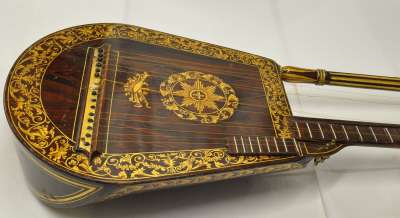String instrument
Dital harps, or harp-lutes, are stringed instruments which became popular in the early 19th century. Ditals were hand-operated levers which pushed up the string, shortening it and thereby raising its pitch.
A number of attempts were made in this period to improve the lute; unlike the traditional instrument, this one would have been played vertically on the lap. Edward Light (c.1747-c.1832) invented the dital harp around 1798; this particular instrument was made by G. Packer of Bath around 1800. These elegant instruments became popular amongst ladies, who would perform with them during the musical soirées so fashionable at the time.
The instrument consists of sixteen strings; an off-set neck with nine main frets, plus seven additional frets for highest notes; three ditals and two oblong sound holes. The frets are made from ivory. Each string is secured by a brass-plated peg with a squared end, operated by a watch-key tuning tool.
The wooden body is gilded with an eight-point star motif, surrounded by a repetitive leaf-design border above a cluster of instruments. Around the edge of the instrument is a border of arabesque and leaf scrolling in gold. The neck of the ‘harp’ is in the form of a fluted column with a Corinthian capital.
This dital harp was donated to RAMM by Mrs. A.C. Chichester of Kerswell, East Devon, in 1880.
A number of attempts were made in this period to improve the lute; unlike the traditional instrument, this one would have been played vertically on the lap. Edward Light (c.1747-c.1832) invented the dital harp around 1798; this particular instrument was made by G. Packer of Bath around 1800. These elegant instruments became popular amongst ladies, who would perform with them during the musical soirées so fashionable at the time.
The instrument consists of sixteen strings; an off-set neck with nine main frets, plus seven additional frets for highest notes; three ditals and two oblong sound holes. The frets are made from ivory. Each string is secured by a brass-plated peg with a squared end, operated by a watch-key tuning tool.
The wooden body is gilded with an eight-point star motif, surrounded by a repetitive leaf-design border above a cluster of instruments. Around the edge of the instrument is a border of arabesque and leaf scrolling in gold. The neck of the ‘harp’ is in the form of a fluted column with a Corinthian capital.
This dital harp was donated to RAMM by Mrs. A.C. Chichester of Kerswell, East Devon, in 1880.
Object Summary
- Accession Loan No.
- A5051
- Collection Class
- Musical instruments
- Material
- wood (painted)rosewoodebony and brass platedebonyivory
- Common Name
- string instrument
- Simple Name
- Musical Instrument
- Period Classification
- George III (1760-1811)
- Production Town
- Bath
- Production Country
- United Kingdom: England
- Production Person Initials
- G
- Production Person Surname
- Packer
- Production Year Low
- 1800
- Production Year High
- 1810


